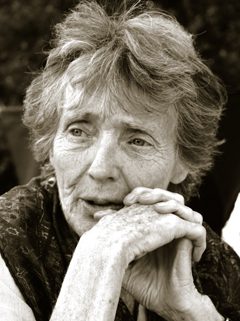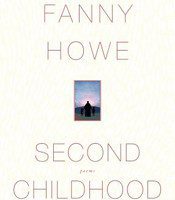The opening poem in Second Childhood, Fanny Howe’s newest collection, is a poem I have been “working on” since I first came across it on The Poetry Foundation’s website last year. By “working on,” I mean I have been drawn into the poem, pulled in as if by force. The poem, titled, “For the Book,” was, when I found it on the website, called, “Yellow Goblins.” In my workshops at Sarah Lawrence College, Rutgers University-Newark, and Eugene Lang College, I have introduced the poem. I say “introduced’ because the poem cannot be “taught.” I told my students what it was about the poem that transported me—that it was a highly concentrated mix of music, synesthesia, and mysticism. In other words, it had the making of what I consider a great poem. Which means it was inexplicable.
Ten or so years ago, when Chelsea was Soho, I stood in a gallery in Soho and stared at an abstract painting by Cecily Brown. I wept. I cannot tell you why: the painting was not figurative. Nothing in the color or in the formal qualities of the painting referenced anything in the world. It was not personal. What it was was: the formal qualities along with the painter’s intuitive decisions created a work of art that somehow touched a part of me that matched the qualities of the painting. My psyche or spirit was affected. I did not know or care why. When finally I walked away from the painting, I was changed.
John Ashbery wrote somewhere that what draws him into a work of art is its incomprehensibility; that, as an art critic, he wanted only to look at and review works that could not be “got.” This is, of course, not the same as intentional crypticism. The way I see it is that the world is complex. To treat the world otherwise is to reduce life or events or people to mere shadows of what they are. But to allow complexity and what I consider a kind of greyness into a work, is to court misunderstanding. We, as Americans (and, I should add, North Americans) tend toward the literal. Even in our poetics. As a result, what we have on the current poetry scene are two succinct binary aesthetics, both rooted in a literal comprehension of the world. On the one hand, we have narrative poetry and on the other, we have what appears, on the surface, to be “experimental” but is, upon closer inspection, simply a rebellion against the narrative: an ironic, nihilistic, hodge podge of words and phrases that claims to reflect the world we live in but paradoxically, by evading any references to the current state of the world, reflects no world at all. In the end, the two are dueling siblings: they reduce complex issues and continue to play out our love of the easily got.
Fanny Howe, the author of more than twenty books including works of fiction, collections of essays and, of course, poetry, pushes up against our treasured love for the reductive. Howe’s work is centered in the world, its dirt, muck, poverty and illness, and in the spiritual. These two, speaking to one another, serve as a kind of lamp or scope, leading her excavations and her art working. When I say “spiritual” I don’t mean the current fondness for new age but, in fact, a Christian belief system with its love and veneration for the poor, the oppressed, and its alignment with justice. To attempt to write about this, Christianity, in the United States is risky. It is risky only because to believe in something we cannot see appears, at first, to be childish; stupid, even. Guile-less, and naïve. Poets, we know better: we have faith in things; in money and power but not in something we cannot see. We are a culture that believes not in helping the powerless and the poor but in competition, in being a winner in the race for power, money, and fame. As poets living in this culture, we do the same. To write about God and belief, to court complexity in one’s writing, is to turn away from power and fame and easy comprehension.
Howe’s newest collection, Second Childhood, embraces these vulnerabilities of the weak, the oppressed. It is a guidebook for turning off ambition and submitting one’s self to a higher cause. It is, perhaps, a poetic equivalent to Thomas Kempis’ Imitation of Christ. Because I cannot paraphrase the poem, nor can I choose one stanza over another, I will quote the poem, “For The Book,” in its entirety:
Yellow goblins
and a god I can swallow.
Eyes in the evergreens
under ice.
Interior monologue
and some voice.
Weary fears, the
usual trails and
a place to surmise
blessedness.
The music is subtle. Like the oars of a rowboat, the music moves the poem forward: “goblins,” and “god,” then “ice” and “voice,” and “trials” and “surmise.” We end up, in the end of the poem with what I call a “tail”: a word, alone, meant to stand apart and reflect the entire piece: “blessedness.”
Note: the word “god” is in lower case. Here, Howe is not referencing the God of powerful churches, not the man in a beard in the sky. Here, by using lower case, she is examining what god is. She has made god small enough, by using lower case, for her, for us, to hold god in our hands, to make god our own. This is the god of the Jesuits, this is the god of the Desert Fathers, a god we can talk to, to return to for comfort and guidance, a god so small and intimate, it is “a god I can swallow.”
 The poem serves as an introduction to the book. In its current iteration, the poem is now titled, “For The Book.” God will be the source throughout—as the author moves through trials and tribulations, spookiness and joy—and, throughout, is able, as a result of her reliance on her god, to find “a place to surmise/blessedness.” The book, in fact, is just that place. As introduction to the introductory poem, Howe chose a quote from Blake: “Fear & hope are—Vision.” Though, as I said, Howe’s poem is not paraphrasable, this quote from Blake comes close to paraphrasing Howe’s poem, “For The Book,” and, in fact, might even be said to nearly paraphrase the entire book.
The poem serves as an introduction to the book. In its current iteration, the poem is now titled, “For The Book.” God will be the source throughout—as the author moves through trials and tribulations, spookiness and joy—and, throughout, is able, as a result of her reliance on her god, to find “a place to surmise/blessedness.” The book, in fact, is just that place. As introduction to the introductory poem, Howe chose a quote from Blake: “Fear & hope are—Vision.” Though, as I said, Howe’s poem is not paraphrasable, this quote from Blake comes close to paraphrasing Howe’s poem, “For The Book,” and, in fact, might even be said to nearly paraphrase the entire book.
The book itself, Second Childhood, is a mix of narrative and more mystical poems. Howe’s strength, though, lies with her more mystical works. The narrative pieces, which tend to be longer, struggle at explaining. As example, in the poem “The Monk and Her Seaside Dreams,” Howe writes:
Let me write about the place again he path so sandy
and the table cloth blowing in a wind from
Newfoundland.
It was here it began. She left her bouillabaisse
untouched
and headed out on a train.
The language and music lose its power in the poem’s attempt to clarify. These poems are the polar opposite of Howe’s poems in the collection that give the reader a sense or what the artist Sterling Ruby calls, an “aura.” About this “aura” Ruby said, in an interview:” I like to think about art as being similar to poetry; it cant be proven. It just exists and there’s an aura about it that people get or don’t get.” This aura is the something that exists in a painting or in a poem. It is the thing that draws us in. It is a kind of magic akin to the magic of childhood and it cannot be explained.
Howe’s collection is titled, Second Childhood. It is the return, as an adult, to the vulnerability, to the stark honesty and guile-lessness of childhood. Simplifying one’s life will do this—ridding one’s self of material objects, for example, or of their spiritual parallel: the ego, pride, judgment, sin, and perhaps most importantly, self consciousness. To e returned to childhood is to be returned to the mystical state of not-knowing, to the Pre-Lapsarian. This is expressed, of course, in Howe’s poem “Second Childhood”:
I have a fairy rosary called Silver who answers
Questions when I dangle her in the sun at the window.
So I’ve asked her if I have a big ego and she swings
From side to side to say no.
We have other children for friends.
We don’t understand why we are here in the world.
To work spiritually, in order to move toward a sense of not-knowing, to see the world anew, like a child—this is the goal of spirituality. Too, this is the goal of great writing or, rather, these are the attributes of a great writer: to see the world as though only coming to it for the first time and then having the ability to demonstrate this strangeness to the reader. In this, Howe is deeply gifted. In her syntax and choice of words and in her vulnerability, she is able to give the reader this gift: the gift of seeing the world as if for the first time. In her poem titled “Second Childhood,” Howe writes:
If we had been grown-ups, we wouldn’t have been
able to see the stars or the storms. We would have
perished.
So my commitment to childhood has once again been
affirmed.
Read the signs, not the authorities.
Here, Howe demonstrates both her ability to see the world as a child as well as her commitment to continue to work to keep this gift or skill, to continue to “read the signs,” and not fall prey to referring first to the “authorities” and their reduced understanding of the world, of the stars. Second Childhood reminds us that we do have a choice: we can either lose ourselves and our lives to the desire for fame, power, and money or we can, instead, work toward moving away from this and back toward childhood and its kingdom of not-knowing, of before-self-consciousness, and the magic that lies there within.





2 responses
Terrific review, Cynthia Cruz. –As well as cogent commentary on poetry today. This sort of writing takes so much time, thought, energy–thank you.
Always a briiliant author my favorite line has always been, teach your sons to be good husbands and your daughters to be doctors.
Click here to subscribe today and leave your comment.